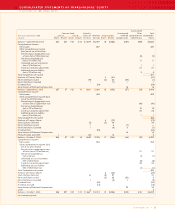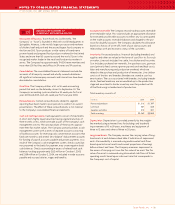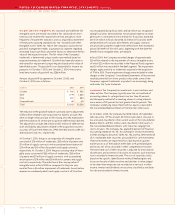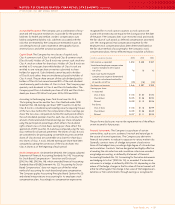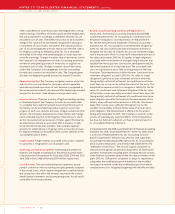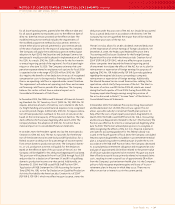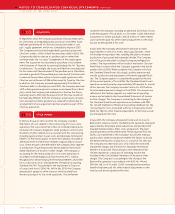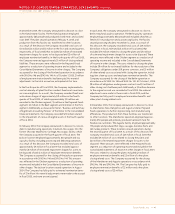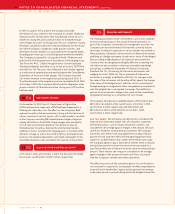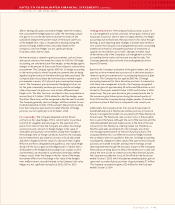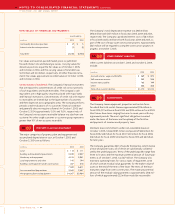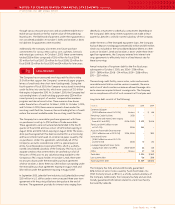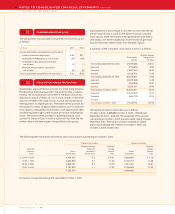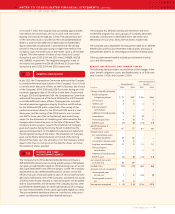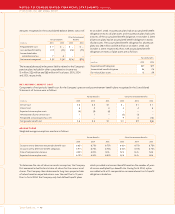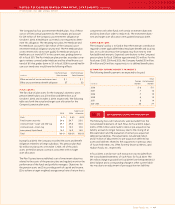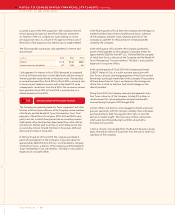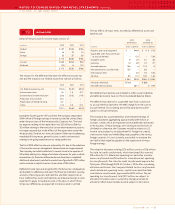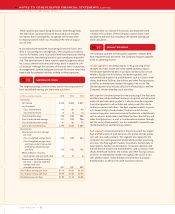Tyson Foods 2005 Annual Report Download - page 44
Download and view the complete annual report
Please find page 44 of the 2005 Tyson Foods annual report below. You can navigate through the pages in the report by either clicking on the pages listed below, or by using the keyword search tool below to find specific information within the annual report.
>> NOTES TO CONSOLIDATED FINANCIAL STATEMENTS (CONTINUED)
TYSON FOODS, INC. 2005 ANNUAL REPORT
Tyson Foods, Inc. >> 42
In the first quarter of fiscal 2003, the Company recorded
$47 million of costs related to the closing of its Stilwell, Oklahoma,
and Jacksonville, Florida, plants that included $26 million of costs
related to closing the plants and $21 million of estimated impair-
ment charges for assets to be disposed. The costs related to closing
the plants include $17 million for estimated liabilities for the resolu-
tion of the Company’s obligations under grower contracts, and
$9 million of other related costs associated with closing the plants,
including plant clean-up costs and employee termination benefits.
The Company accounted for closing the Stilwell, Oklahoma, and
Jacksonville, Florida, operations in accordance with Emerging Issues
Task Force No. 94-3, “Liability Recognition for Certain Employee
Termination Benefits and Other Costs to Exit an Activity” (EITF 94-3)
and SFAS No. 144. The costs were reflected in the Chicken segment
as a reduction of operating income and included in the Consolidated
Statements of Income in other charges. The Company recorded
a $4 million increase to the original accrual during fiscal 2004. A
$1 million decrease to the original accrual was recorded in fiscal 2005.
At October 1, 2005, the Company had fully paid its obligations under
grower contracts of $16 million and other closing costs of $13 million
had been paid.
BSE-RELATED CHARGES
>> 04
On December 23, 2003, the U.S. Department of Agriculture
(USDA) announced a single case of BSE had been diagnosed in a
Washington State dairy cow. The effect on the Company’s Beef
segment caused by that announcement, along with the decision of
various countries to restrict imports of U.S. beef products, resulted
in the Company recording BSE-related pretax charges of approxi-
mately $61 million in fiscal 2004. These charges were included in
cost of sales and primarily related to the decline in value of
finished product inventory destined for international markets,
whether in-transit, located at the shipping ports or located within
domestic storage, as well as live cattle inventory and open futures
positions. No material adjustments were made subsequent to the
initial BSE-related accruals recorded in first quarter of fiscal 2004.
ALLOWANCE FOR DOUBTFUL ACCOUNTS
>> 05
At October 1, 2005, and October 2, 2004, the allowance for doubt-
ful accounts was $9 million and $11 million, respectively.
FINANCIAL INSTRUMENTS
>> 06
The Company purchases certain commodities, such as corn, soybeans,
livestock and natural gas, in the course of normal operations. As
part of the Company’s commodity risk management activities, the
Company uses derivative financial instruments, primarily futures
and swaps, to reduce its exposure to various market risks related to
these purchases. Generally, contract terms of a financial instrument
qualifying as a hedge instrument closely mirror those of the hedged
item, providing a high degree of risk reduction and correlation.
Contracts that are designated and highly effective at meeting the
risk reduction and correlation criteria are recorded using hedge
accounting, as defined by Statement of Financial Accounting
Standards No. 133, “Accounting for Derivative Instruments and
Hedging Activities” (SFAS No. 133), as amended. If a derivative
instrument is a hedge, as defined by SFAS No. 133, changes in the
fair value of the instrument will be either offset against the change
in fair value of the hedged assets, liabilities or firm commitments
through earnings or recognized in other comprehensive income (loss)
until the hedged item is recognized in earnings. The ineffective
portion of an instrument’s change in fair value will be immediately
recognized in earnings as a component of cost of sales.
The Company had derivative related balances of $117 million and
$87 million recorded in other current assets at October 1, 2005,
and October 2, 2004, respectively, and $125 million and
$83 million in other current liabilities at October 1, 2005,
and October 2, 2004, respectively.
Cash flow hedges: The Company uses derivatives to moderate the
financial and commodity market risks of its business operations.
Derivative products, such as futures and option contracts, are
considered to be a hedge against changes in the amount of future
cash flows related to commodities procurement. The Company
also enters into interest rate swap agreements to adjust the pro-
portion of total long-term debt and leveraged equipment loans
subject to variable interest rates. Under these interest rate swaps,
the Company agrees to pay a fixed rate of interest times a notional
principal amount and to receive in return an amount equal to a
specified variable rate of interest times the same notional principal
amount. These interest rate swaps are considered to be a hedge
against changes in the amount of future cash flows associated
with the Company’s variable rate interest payments.
The effective portion of the cumulative gain or loss on the deriva-
tive instrument is reported as a component of other comprehensive
income (loss) in shareholders’ equity and recognized into earnings
in the same period or periods during which the hedged transaction



